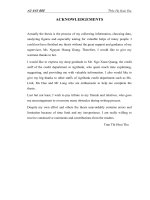A minor research on current situation and recommendations for the development of individual customer services in ocean bank – hanoi branch
Bạn đang xem bản rút gọn của tài liệu. Xem và tải ngay bản đầy đủ của tài liệu tại đây (827.91 KB, 69 trang )
ACKNOWLEDGEMENT
First and foremost, my deepest gratitude goes to my supervisor – MA.
Tran Thu Hoai for her relentless encouragement and continual support. Her
tireless enthusiasm and patience in assisting me throughout the research process
have always been graciously appreciated from the beginning to the end. This
dissertation would not have been possible without her insightful advice and
guidance.
Ms. Do Thu Phuong also deserves my utmost appreciation. Her invaluable
contributions and suggestions to research are highly valued, particularly during
the qualitative phase of the study. I am so greatly indebted to her for providing
me extremely important and necessary information to accomplish this paper. I
would also like to acknowledge the thoughtful support and guidance of Mrs.
Pham Dinh Yen – the executive director.
Last but not least, I would like to express my heartfelt appreciations to my
parents, my sister as well as Academy of Finance and its administrators who
have all provider me with substantive support and encouragement throughout
the investigation of customer service at Ocean bank. I would have been
impossible for me to have completed this work without them.
i
ABSTRACT
The graduation paper presents filtered data on Ocean bank’s annual reports
and compatible information in academic books. Through collecting and
synthesizing data and raw materials, the paper conducts an investigation on the
situation of customer service in retail banking system. Subsequently, there is a
more deeply analysis implemented in order to build the foundation of solutions
in chapter 3. The analysis concentrates on the current situation of the tree main
sectors – savings, credit and card service. In this way, the bank’s performance
can be evaluated in accordance with a set of both quality and quantity criteria.
Hence, the paper indicates the strong and the weak points of the bank’s
organization to have a comprehensive view of Ocean bank’s individual
customer service. The most important sector is focused on the recommendations
for stimulating personal banking in Ocean bank including product, customer
strategy, risk management, human resource development and some of proposals
to the SVB.
ii
LIST OF ABBREVIATIONS
ATM
Automatic Teller Machine
GDP
Gross Domestic Product
HB
Hanoi Branch
HDR
Human Resource Development
IT
Information Technology
NPL
Non-performance Loan
POS
Point of Sale
SBV
The State Bank of Vietnam
SME
Small – Medium Entrepreneur
iii
LIST OF FIGURES & TABLES
Number
1
Name
Table 2.1.
Profit result of Ocean bank – Hanoi
Page
26
Branch
2
Figure 1.1 Source of mobilization
29
3
Table 2.2. Fund raising from resident
29
4
Table 2.3. The data for total capital and total credit
32
in Ocean bank (HB)
5
Table 2.4. Development of card operations
35
iv
REFERENCES
Sources in English:
1. Andres Kuusik. (2007), Affecting customer loyalty, University of Tartu, 9-11.
2. Bilal Afsar, Zia Ur Rehman, Jaweria Andleeb Qureshi and Asad Shahjehan.
(2010), Determinants of customer loyalty in the banking sector, Department of
Management Sciences, Hazara University, Pakistan, 1041-1043.
3. Beatriz Sanz Saiz and Pierre Pilorge. (2010), Understanding customer
behavior in retail banking, Ernst & Young.
4. Effie Xin, Lawrence Luo and Sky So (2010), Market risk management, Ernst
& Young.
Internet sources:
5. Hiệp hội ngân hàng Việt Nam (2011), Phát triển dịch vụ ngân hàng bán lẻ,
retrieved from />6. Thanh niên news (2013), Bank bad debts remain serious challenge for
Vietnam: ADB chief, retrieved from />7. Ocean bank official website (2013), Overview of Ocean bank, retrieved from
/> Vietnamese sources:
8. Báo cáo thường niên của Ocean bank (2010, 2011, 2012).
9. Tạp chí Ocean times.
v
TABLE OF CONTENTS
ACKNOWLEDGEMENT ...................................................................................... i
ABSTRACT ........................................................................................................... ii
LIST OF ABBREVIATIONS ...............................................................................iii
LIST OF FIGURES & TABLES .......................................................................... iv
INTRODUCTION .................................................................................................. 1
CHAPTER 1: LITERATURE REVIEW ............................................................... 5
1.1.
Overview of a commercial bank................................................................... 5
1.1.1. Definition of a commercial bank .................................................................. 5
1.1.2. Functions of a commercial bank................................................................... 5
1.1.2.1. Primary functions ......................................................................................... 5
1.1.2.2. Secondary functions ................................................................................... 10
1.2.
Classification of services in a commercial bank ........................................ 12
1.3.
Individual customer service in a commercial bank .................................... 13
1.3.1. Definitions of customer service in a commercial bank .............................. 13
1.3.2. Individual customer services in a commercial bank .................................. 14
1.3.2.1. Savings service (Savings account) ............................................................. 14
1.3.2.2. Personal credit service ................................................................................ 15
1.3.2.3. Payment service .......................................................................................... 15
1.3.2.4. Account service .......................................................................................... 16
1.4.
Overview of developing individual customer service in a commercial
bank
.................................................................................................................... 17
1.4.1. The importance of good customer service ................................................. 17
1.4.2. Evaluation criteria for ability of building customer base ........................... 17
1.4.3. Factors influencing on remaining customer loyalty toward a bank ........... 19
CHAPTER 2: CURRENT SITUATION OF THE DEVELOPMENT OF
INDIVIDUAL CUSTOMER SERVICE IN OCEAN BANK - HANOI
BRANCH ............................................................................................................. 22
2.1.
An overview of Ocean Bank – Hanoi Branch ............................................ 22
2.1.1. An overview of Ocean Bank ...................................................................... 22
2.1.2. An overview of Ocean Bank – Hanoi Branch ............................................ 23
2.1.2.1. History of Ocean Bank – Hanoi Branch ..................................................... 23
2.1.2.2. Functions of Ocean Bank – Hanoi Branch ................................................. 24
2.1.2.3. Organization of Ocean Bank Hanoi Branch ............................................... 24
2.1.2.4. Performance of Ocean Bank – Hanoi Branch ............................................ 25
2.2.
Current situation of the development of individual customer service in
Ocean Bank ............................................................................................................. 27
2.2.1. Current situation of savings mobilization activities .................................. 27
2.2.1.1. Type of ordinary savings rendered by Ocean bank .................................... 27
2.2.1.2. Structure of mobilizing ............................................................................... 28
2.2.1.3. Current situation in 2011 ............................................................................ 29
2.2.2. Current situation of personal credit ............................................................ 30
2.2.2.1. Personal credit product ............................................................................... 30
2.2.2.2. Current situation in 2011 ............................................................................ 31
2.2.3. Current situation of card service ................................................................ 34
2.2.3.1. Types of card services ................................................................................ 34
2.2.3.2. Current situation in 2011 ............................................................................ 35
2.3.
Evaluation of current situation of individual customer service in Ocean
Bank
.................................................................................................................... 37
2.3.1. Achievements ............................................................................................. 37
2.3.1.1. Quantity ...................................................................................................... 38
2.3.1.2. Quality ........................................................................................................ 39
2.3.2. Weakness and Causes ................................................................................. 40
CHAPTER 3: RECOMMENDATIONS FOR DEVELOPING INDIVIDUAL
CUSTOMER SERVICE IN OCEAN BANK – HANOI BRANCH ................... 43
3.1.
Developing orientation of individual customer service in Ocean Bank –
Hanoi Branch........................................................................................................... 43
3.1.1. Developing orientation of retail banking in Vietnam................................. 43
3.1.2. Developing orientation of individual customer service in Ocean Bank .... 45
3.2.
Recommendations for further enhancement of individual customer
services in Ocean bank ............................................................................................ 47
3.2.1. Product strategy .......................................................................................... 47
3.2.2. Customer strategy ....................................................................................... 49
3.2.2.1. Existing customer remaining ...................................................................... 50
3.2.2.2. New customer developing .......................................................................... 51
3.2.3. Risk management ....................................................................................... 52
3.2.3.1. Credit risk ................................................................................................... 52
3.2.3.2. Market risk .................................................................................................. 53
3.2.3.3. Operational risk .......................................................................................... 54
3.2.4. Human resource development (HRD) ........................................................ 56
3.2.5. Recommendation for the SBV.................................................................... 57
CONSLUSION........................................................................................................ 58
REFERENCES ...................................................................................................... v
INTRODUCTION
1. RATIONALE OF THE STUDY
In line with the development of Vietnam’s economy, banking system on
the whole has been widening vertically and horizontally. Its powerful influence
on financial system has been making it one of the core parties of the economy
contributing to the national growth. In which, commercial banks are emerging
as a new pillar of banking system in the 21st century.
The evolvement of commercial banks, in the context of international
integration of Vietnam, needs creativeness in management style and
sensitiveness in keeping up with the world’s situation. An opening economy has
been bringing opportunities and difficulties to the whole banking system due to
an increasing number of internal and external “competitors” – financial
intermediaries and institutions. This requires commercial banks to be more
active in order to accelerate added-value and expand the coverage of banking
system through raising regulation capital. Throughout two decades of
development, Ocean commercial joint-stock bank is becoming stronger with the
regulation capital of in and around 5,000 billion VND, offering various utility
services, especially, E-banking (internet banking, home banking, e-loans), and
having a strategic partnership with Petro Vietnam.
Like any other banks, Ocean Bank – Hanoi Branch are conducting
numerous strategies and plans in which individual customer services have been
taken into consideration as an inevitable laws of the market economy for the
purpose of attracting customers. Individual customer services in Ocean Bank –
1
Hanoi Branch have reached some certain advances; however, there is a need to
have a deep understanding of strength and weakness of the services and then to
give out valuable recommendations to the board of director.
Recognition of the topic of relevance, I have decided to conduct a minor
research on current situation of individual customer services in Ocean Bank –
Hanoi Branch to have an overview as well as a comprehensive look into the
growth of the services. Subsequently, I would like to present some
recommendations to enhance the services and operating efficiency.
2. AIMS OF THE STUDY
The specific aims of the research are:
- To present the background of banking system in general and
commercial bank in particular
- Next, to list common banking services and then a detailed look into
individual customer service in Ocean Bank – Hanoi Branch.
- Afterward, to assess the current situation of the development of
individual customer service in Ocean Bank – Hanoi Branch in a certain
period of time.
- Ultimately, to submit some recommendations to improve efficiency and
effectiveness of individual customer service in Ocean Bank – Hanoi
Branch
It is expected that this minor research might be helpful to the board of
directors in developing strategic plans, exploring new market, and branch
expansion.
2
3. METHOD OF THE STUDY
In order to perform this research, I firstly intend to use the method of
collecting, synthesizing materials and books to form theoretical background.
Subsequently, I analyze collected raw materials to have an overview of the
situation, achievements, and constraints. Simultaneously, I observe employee
and customer’s attitude to evaluate influences. By doing so, I can propose
compatible recommendations to enhance the services.
In the process of writing this paper, I also base myself on the knowledge
I have learnt from my teachers, my supervisors and from other references
(Internet, magazines, and book).
4. SCOPE OF THE STUDY
Due to some certain capacity constraints, the paper will be limited as the
title suggests: “A minor research on current situation and recommendations for
the development of individual customer services in Ocean Bank – Hanoi
Branch”, to touch upon some following issues:
- The background of the whole banking system as well as commercial
bank.
- Evaluation of the development status of individual customer services in
Ocean Bank (Hanoi Branch).
- The compatible recommendations for improving and branch expansion.
5. ORGANIZATION OF THE STUDY
The study is divided into three sections:
3
The first section is the introduction dealing with the rationale, aims, methods,
scope, organization and significance of the study.
The second section is the crucial section of the thesis with three chapters:
Chapter 1 is the investigation of variety of individual customer services
in Ocean Bank. This chapter will cover the different type of individual customer
services, the influences of external and internal factors on development.
Chapter 2 mentions to overview of Ocean Bank (Hanoi Branch) in
recent years, the current situation of individual customer services, and this
chapter would include assessment of achievements, weakness and causes.
Chapter 3 refers to overview of developing orientation of the bank in
the following years, and then gives recommendations for economic plan,
marketing plan, and technological application.
The last section is the conclusion that summarizes the content of the thesis,
gives a list of sources of reference information and reference books.
4
CHAPTER 1: LITERATURE REVIEW
1.1.
Overview of a commercial bank
1.1.1. Definition of a commercial bank
Commercial banks play a key role in the economy both at national and
global level. The importance of commercial banks include the fact that they
serve as a trusted and safe place where the funds of people and businesses can
be kept on their behalf, reducing the necessity to keep large sums of money on
the private or business premises, etc. Hereby, commercial bank’s definition
extracted from Wikipedia is given below:
“A commercial bank is a profit-seeking business firm, dealing in money
and credit. It is a financial institution dealing in money in the sense that it
accepts deposits of money from the public to keep them in its custody for safety.
So also, it deals in credit, i.e., it creates credit by making advances out of the
funds received as deposits to needy people”
1.1.2. Functions of a commercial bank
1.1.2.1. Primary functions
Accepting deposits
Acceptance of deposits is the main function of a commercial bank
mobilizing savings of the household sector. Banks generally accept three types
of deposits:
Current deposits
Current deposits which are also known as demand deposits can be
withdrawn at any time. Generally, no interest is allowed on current deposits,
5
and in case, the customer is required to leave a minimum balance undrawn with
the bank. These deposits are kept by businessmen and industrialists who receive
and make large payments through banks. The bank collects certain incidental
charges on the customer for the services rendered by it.
Saving deposits
In addition to current savings, saving deposits is one of the most prominent
types of deposits preferred by individual customer group. It is used mainly for
professional men and middle class people to help them deposit their small
savings. Money can be deposited at any time but the maximum cannot go
beyond the certain limit. There is a restriction on the amount being withdrawn
at a particular time or a short-time. Interest is allowed on the credit balance of
this account. The rate of interest is greater than that for current deposits and less
than that for fixed deposits.
Fixed deposits
While saving deposits have a fairly flexible interest rate, fixed deposits are
reverse. These are also known as time deposits and cannot be withdrawn before
the expiry date that the amount of money is deposited, otherwise customers
have to give a prior notice for their withdrawals. In the case of emergency,
depositor pays a slightly higher rate of interest for the bank to borrow money.
The rate of interest paid for these deposits is usually higher for longer period.
Fixed deposits are still preferred by depositors regardless of its inflexibility
because of their safety and interest rate.
Advancing loans
6
Besides capital raising field, making loans are among the most profitable
activities in bank. Lending is made to all types of persons, particular to
businessmen and entrepreneurs. Loans are also made against personal security,
gold and silver, stocks of goods and other assets. Some of the most common
ways of lending are:
Overdraft facilities
Overdraft facility is a formal arrangement with a bank that allows the
depositor in a current account to draw on funds in excess of the amount in his
account (on deposit) up to a previously agreed limit. The additional amount of
money that is borrowed from the bank will be charged by the bank. This type of
financing is most commonly used by businesses as a way of making their
working capital more flexible, though it can also be available to individuals.
Cash credit
With many of the advantages of a standard line of credit, cash credit is the
issuance of a short term cash loan to a business. Cash credit works in a manner
that is very similar to that of a line of credit. The difference is that it establishes
a cash account with the lender institution. Under this account, the bank gives
loans to the borrowers against certain security. The entire loans is not given at a
particular time, instead the amount is credited into the borrower’s account in the
bank and only given in case of emergency. Besides, the bank can also give
specified loan to a person, a firm against some collateral securities.
Discounting bills of exchange
Purchasing and discounting bills of exchange is another short-term
method of profitable instrument of bank funds. These are held by the holders in
7
which they can be discounted by the bank when the holders are in need of
money. The present price of the bills will be given to the holder after deducting
its commission. It is considered as a good investment for a bank because it
provides a very liquid asset. The discounted bills can be rediscounted with the
central bank by commercial banks.
Money at call
Many different types of financial instruments can be “called” or declared
payable immediately by the lender. A financial institution as commercial bank
can grant loan for a very short period, generally not exceeding 7 days to the
borrowers, dealers or brokers in stock exchange markets for some collateral
securities like equity shares, stock, etc., offered by them. After that, the issuer
can decide to force the holder to redeem such advances after a short time,
meaning that “money is called”.
Term loans
A loan from a bank that has a specified repayment schedule and a floating
interest rate gives to traders, industrialists, agriculturists against some collateral
securities. Term loans are generally provided as working capital funds at once
to the borrowers for acquiring income producing assets (machinery, equipment,
and inventory) that generate the cash flows for repayment of the loan. Maturity
period of term loans usually lasts from 1 to 10 years.
Consumer credit
Consumer credit is basically the amount of credit used by consumers to
purchase non-investment goods or services that are consumed and whose value
depreciates quickly. This credit is given to households in a limited amount to
8
buy some consumer goods and meet some personal needs like payment of
school fees, electrical bills, wedding fees, purchasing of automobiles,
recreational vehicles, boat, house, etc.
Creating credit
The commercial banks are the second most importance sources of money
supply exclude the SBV and the money supplied by the commercial banks is
called “credit money”. This is an unique function of the banks that not only
provides funds for traders and businessmen but also acts as manufacturer of
money. Bank deposits are regarded as money because it can be used to purchase
goods or services and settle debts. A bank can give a loan to its customers
through crediting the account of the borrower and do not have to receive cash.
Then, the borrower can withdraw the amount whenever he wants by cheque.
These help reduce the volume of money in circulation, simultaneously, curb the
inflation.
Promoting the use of cheques
A cheque is a document that orders a payment of money from a bank
account. It is a cheap medium of exchange rendered by commercial banks. The
cheque is considered much more convenient and safer to settle debts rather than
the use of cash.
Financing internal and foreign trade
The bank finances internal and foreign trade through discounting of
exchange bills. Sometimes, the bank gives short-term loans to trader on the
security of commercial papers. These greatly facilitate the movement of internal
9
and external trade.
Remitting funds
Commercial banks, on account of their network of branches throughout the
country, also provide facilities to remit funds from one place to another place
for their customers by issuing bank drafts, mail transfer or telegraphic transfers
on nominal commission charges. In comparison with postal money or other
instruments, the bank draft is a much cheaper mode of transferring money.
1.1.2.2. Secondary functions
Agency services
Banks also perform certain agency functions for and on behalf of their
customers. These services have a wide range of value and are mentioned below:
Collecting and making payment of credit instrument
Banks collect and pay various instruments like cheques, bills of exchange,
promissory notes, etc, on behalf of their customer.
Dealing with securities and dividends on shares
Commercial banks purchase and sell common securities like stocks, shares,
bonds, debentures. Subsequently, they collect dividend and interest on shares
and debentures of their customers and credit them to their account.
Acting as correspondent
Banks are representatives or correspondents for their customer for some
time to get passports or travel’s ticket.
Consulting income-tax
10
Bank sometimes may recruit income tax experts to prepare income tax return
and help their customers get refund of income tax.
Executing standing order
Various periodic payments can be made by banks that are entrusted by their
customers.
General utility services
In addition to agency services, the modern banks provide many newly
developed utility services that help the community enjoy modern life standards
and are given below:
Locker facility
Banks provide locker facility to their customers for keeping personal properties
like gold, silver ornament, important documents, shares and debentures.
Letter of credit
Letter of credit are issued by the banks to their customers certifying credit
worthiness of owners. Letters of credit are very useful in foreign trade,
especially for exporter or importer.
Underwriting securities
Banks gather crucial information relating to finance, commerce, and
banking then have valuable reports, journals on economic and financial matters.
Hereby, they underwrite the shares and debentures owned by the government,
public and private companies for the first IPO.
11
1.2.
Classification of services in a commercial bank
The services that commercial banks offer have changed greatly and
become verified since the 20th century because of deregulation, the expansion of
information technology, and innovations in the type of services offered.
However, basically, customer group is divided into three groups.
Services for Corporation
Banking services for large corporations or firms are designed to deal with
major financial transactions, cash management, and other banking services
custom-tailored for large firms.
Main services for corporation are credit service provided for expanding
and enhancing manufacturing and business activities, savings service, and
payment service including domestic payment and international payment (Letter
of credit for importing and exporting, , collection of importing and exporting,
money transferring).
Services for Individuals
Personal banking encompasses the range of products and services offered
by a bank to individuals. Included are checking and saving accounts, loans and
mortgages, safe deposit boxes, certificates of deposit, money orders, traveler’s
cheque and bank draft. Nowadays, the diversification of personal services has
been growing through applying technological improvement.
Generally, there are four main categories: personal credit service that is
provided for the purpose of individual consuming (shopping for lady, house and
car purchasing) and exclude some regulations of individual income, account
12
service, savings service (Savings account), and payment service which includes
cheque, domestic and oversea payment.
E-banking and card service
E-banking is a newly developed service that takes advantages of high
technology. It plays a great role in transforming banking business into ebusiness through utilizing e-channels. E-banking is likely to extend the market,
lower transaction cost or process more financial transactions. Currently,
commercial banks focus on developing the services through internet, mobile,
thereby, banking services have become more familiar with the public.
Besides, card service has been boosted in order to modernize human life
through daily financial transaction without cash. Some activities applied card
service are payroll payment, bill paying, remittance of money, etc. Moreover,
other types of card service are also developed strongly like credit card, debit
card, master card, etc.
1.3.
Individual customer service in a commercial bank
1.3.1.
Definitions of customer service in a commercial bank
Turban et al (2002) stated that “Customer service is a series of activities
designed to enhance the level of customer satisfaction-that is, the feeling that a
product or service has met the customer expectation”. The perception of such
interactions will be dependent on employees “who can adjust themselves to the
personality of the guest” according to Micah Solomon. Similarly, Julia Penny
(2013) shows a very interesting definition of customer service, that is,
“Customer service is the degree to which a product or service fails to meet,
13
meets or exceeds customer’s expectations. It defines the customer’s perception
of the interaction with the company”
1.3.2. Individual customer services in a commercial bank
1.3.2.1. Savings service (Savings account)
The most common type of bank account and probably the first account that
customers will ever have (after a checking account), is savings account. It is
opened in banks by salaried people or by the people who have idle money (it is
also available for students, senior citizens, pensioners…). Saving account is
designed to promote savings therefore, the main features of savings account can
be showed by its name. Firstly, normally, there is no restriction on the number
and amount of deposits making it a flexible and preferable account. Secondly,
withdrawals are allowed either by cheque or slip of respective bank, however, it
includes some certain restrictions. Thirdly, customers will be satisfied because
saving account has no maximum period of holding, hereby, savings will be kept
and generate accumulated interest until it is withdrawn by the holders. Finally,
in the context of development of hi-tech, e-banking is born as a new and
prominent channel of distribution that is available to pay daily (routine)
expenses for clients through savings account.
Savings accounts have various advantages in which allow customers to
keep their money in a safe place while it earns a small amount of interest each
month; therefore, it encourages savings habit among salary earners and others
who have fixed income. In addition, it enables the depositors to do online
shopping and keeps records of the transactions carried, hereby, they can control
their own financial situation. Nonetheless, these accounts usually require either
14
a low minimum balance, or require no minimum balance at all depending on the
bank and type of account.
1.3.2.2. Personal credit service
Credit products are provided by commercial banks for individuals to do
some personal consuming. For individuals, personal credit service helps people
to satisfy their needs of small spending (shopping, bill paying) and big spending
(housing, car, land purchasing) but do not need to wait for having sufficient
money.
For bank, when money is loaned out, there must be reasonable expectation
of repayment of the loan, plus interest, thus loans constitutes the most profitable
asset group to bank through a high rate of interest. Because of requirement of
repayment capacity of individuals, there are various questions given out and
evaluating process happened to confirm financial status of the individuals.
Credit contract provides fully information about interest, terms, payment
facility and other rules to assure mutually beneficial arrangement.
Furthermore, bank also offers a modern payment facility - “credit card”
against people who have the certain amount of fixed salary to show their status
symbol. Client’s credit limit is a maximum amount they can charge on the card
including purchases, balance transfer, cash advances, finance charges, and fees.
When clients go over their credit limit, creditor may charge a fee - an over-thelimit fee.
1.3.2.3. Payment service
Payment system encompasses a set of instruments and means generally
acceptable in making payment (cheque, credit card, debit card). The payment
15
services are offered and operated by bank through deliver channels (bank tellers,
ATMs, EDCs, computers, mobile phones, and others) resulting in creating an
interbank funds transfer system that boosts the circulation of money and goods
between economic agents using an accepted medium of exchange. A modern
payment system typically has a range of specialized subsystems developed to
serve particular sets of customers.
Presently, because clients are always expecting their needs to be satisfied
promptly, banks have been modernizing payment service daily through
applying IT, developing many new instruments such as mobile payment, online
payment, and card payment. Moreover, domestic and oversea remittance service,
western union service, and cheque service which are common services in banks
can be used and registered easily to execute small transactions or merely to
transfer money.
1.3.2.4. Account service
The term “Account service” relates to a new kind of service that banks
offer for the purpose of helping clients to manage their finance efficiently. Its
aims are time-saving and paper-saving. Because it is “a new-born service”,
account service is not really popular in Vietnam’s banking system. Some
available utility accounts offered by Ocean Bank are auto-saving account or
“Thach Sanh” overdraft account.
16
1.4.
Overview of developing individual customer service in a commercial
bank
1.4.1. The importance of good customer service
In Mr. Mukherjee’s speech - Minister of finance of New Delhi, he said
“Good customer service is the heart of banking service delivery. Banking is
predominantly a customer-oriented business and good customer service is the
key to bank’s growth and stability”. That is, in fact, there is a famous business
slogan that: “The customer is always right”. The underlying truth behind this
statement is recognizing that customers are the life blood for any business
including banks. Understanding the importance of good customer service is
essential for a healthy business in creating new customers, keeping loyal
customers, and developing referrals for future customers.
Customer service quality has been viewed as a significant issue in
customer retention. Since banking services are generally characterized with
undifferentiated products, it is imperative for banks to strive for improved
service quality if they want to distinguish themselves from the competition.
Improvement in quality of service is related to expansion of market share. In the
current marketing literature, much attention on service quality as related to
customer’s attitude toward services is focused on the relationship between
customer expectations of a service and the perceptions of the quality.
1.4.2. Evaluation criteria for ability of building customer base
Like any other businesses, banks also need to build trust, set up customer
network, offer their services and products and then make profit; therefore, a
bank with bad customer service always cause a bad result of bottom line.
17









